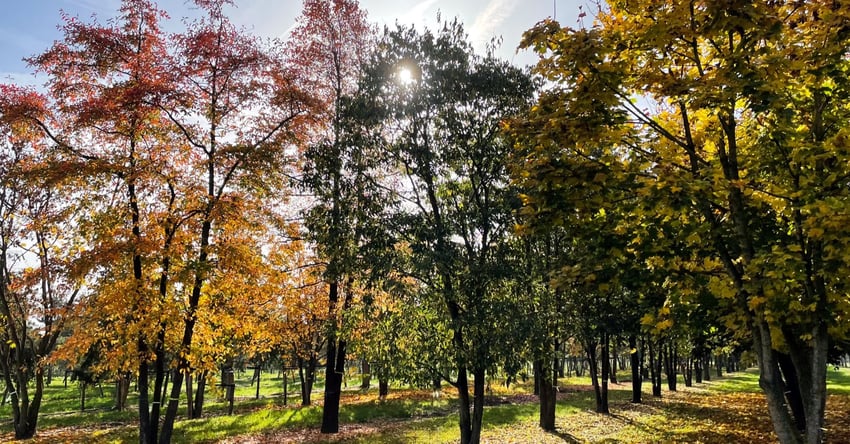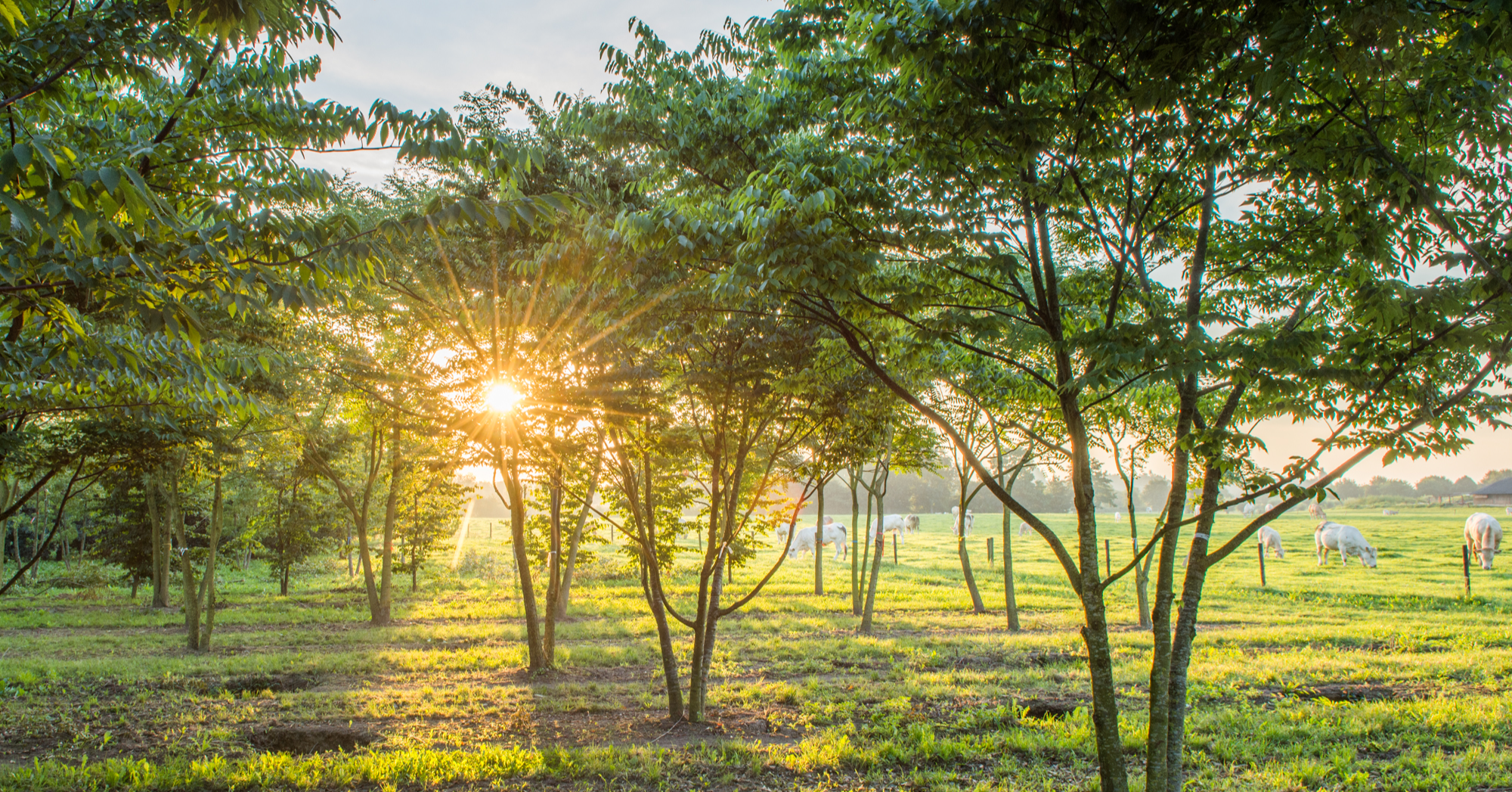Impact of light and shade in a planting design

A planting design is not just about proportion, colour and form but also light and shade. After all, it is a question of creating contrast. Trees can produce striking light effects. By ensuring variety, taking into account the density of a tree canopy and foliage type, you can filter bright sunlight, form deep shade or a subtle variation of the two. Once you are familiar with the light characteristics of the tree, use them to add an extra dimension to your design.
Light filter and shade planting
Foliage and branches filter sunlight falling in the tree canopy, creating a pattern of light and shade on the ground. The interplay between (fine) foliage and the wind gives a diffuse and mottled light pattern, creating a soft effect. Where strong sunlight may be uncomfortable and dominant, a tree can create a pleasant place by filtering the light. We tend to associate shade with coolness and sunny spots with heat. With the increasing number of summer heatwaves, the need for cooling, and consequently shady areas, is on the rise. However, too much shade in spring or autumn may quickly be perceived as being cold rather than offering refreshing shade. Light is also essential for photosynthesis and thus growth of plants. This is why it is important to consider shade-tolerant underplanting. Characteristic for shade planting is to achieve a very serene look in keeping with the shady ambience. In a design, the serene groups of foliage plants in the shade, therefore, often make a nice contrast to the colourful, sunny sections. An additional benefit is underplanting in the shade is much more stable than in sunny sites. And so, requires less maintenance. In the wild, it is part of the climax vegetation which is more subdued compared to sun-drenched flora which is vibrant because it is in a much younger succession stage.
Light exposure and shade
By shade, we refer to areas where sunlight is suppressed by the foliage, branches and trunks of the trees. These shady areas may vary in intensity, depending on factors such as density of the foliage and angle of the sun. Shadows formed by the tree canopy offer relief against direct sunlight and create a cooler space beneath the trees. They also contribute to the aesthetics of the design owing to the contrast between light and dark. In short, light conditions determine how light is distributed in a place, shade being an absence of light, for example via an obstruction in the form of a tree or building.
In a planting design around a building, it is important also to take into consideration harsh shadows created by that building and any others in the vicinity. As soon as the sun has passed the buildings, the plants are directly in full sun. In addition, light may come from an unexpected side via light reflections from an adjacent building or reflective materials such as glass and light-coloured paving. Are you designing a roof garden? If so, also factor in radiation from adjacent roofs, façades and solar panels.
Natural shading screen
Shade is often also regarded as something negative. For example, because people want light in buildings and warm places in the sun. Fortunately, nature has its own device; in the summer when you want to keep the sun out of the house and it is too hot to sit outside in the sun, a tree has leaves which act as a natural shading screen. In winter or spring, when you welcome the sun in your home or when you want to warm yourself in the first rays of the sun, the tree is still bare and light is merely filtered through some branches. Sun canopies/awnings and air conditioning are not necessary and we can enjoy the finest shade there is: natural shade.
Tree form, branching structure and composition of foliage
In order to determine the correct tree species a number of aspects need mentioning. The tree form and composition of the foliage play a role but also transparency of the crown, branching structure and foliage colour. To ascertain the desired light conditions, you need to start by selecting the tree form. A multi-stem tree for example is often a broad plant that quickly gives a sense of enclosure and casts a wide shadow. If you want to achieve this effect with standard trees you will have to plant several specimens as a group. If you opt for a feathered, block-shaped or espalier, the branching, enclosure and transparency are significantly different. The form and structure of a tree’s foliage can reveal much about the degree of shade. Many trees with a composite leaf have a semi-open crown structure and provide light, filtered shade. Species such as Acer negundo, Gymnocladus dioica, Gleditsia triacanthos, Koelreuteria paniculata, Juglans nigra and Robinia pseudoacacia are good examples of this. Tree species with a deeply cut leaf (Laciniata) often have an open/entirely transparent crown structure and barely cast any shadow. Such examples being Alnus glutinosa ‘Laciniata’, but also Juglans nigra ‘Laciniata’. Just like trees with a composite leaf, species with small-sizes leaves often provide beautiful diffuse light conditions, for instance Celtis sinensis, Zelkova serrata and Ulmus parvifolia. Worth mentioning here are also trees with large foliage and also a fairly open crown structure such as Catalpa, Liriodendron, Magnolia, Paulownia, Toona, and Ulmus 'New Horizon'). With the increase in ultraviolet index and extended periods of hot weather, the cooling capacity of a tree is becoming ever more crucial. Species that cast a deep shade effect such as, Platanus orientalis and P. hispanica (plane), Tilia (lime), Fagus (beech), Acer platanoides (maple) and Aesculus (horse chestnut) are ideal options.
Evergreen
One last group which must not be underestimated in terms of added value in a planting design are evergreen species and those that keep their leaves in the winter time. Broadly speaking, between November and April a garden is entirely bare. Evergreen species can make a huge difference in this period. Not only in terms of trees and shrubs but also perennials. Trees and shrubs that keep their leaves in winter time, although not truly evergreen, do often provide the right winter effect. For instance, species such as Fagus (beech) or Buddleia (Butterfly bush). Virtually all evergreen trees cast deep shade all year round. They often have a densely branched and enclosed crown. This also has the advantage that they can be pruned to create a nice form. Repeating clouds of Osmanthus or a linear pattern of a tight hedge such as Taxus are a delight to behold, even in winter. So as to create a not too sombre ambience, we often combine these with light-coloured perennials. Examples of evergreen trees with dense branching are Taxus baccata, Quercus ilex and Sequoia sempervirens.
Light, and lack of light, constitutes a fundamental aspect for how we experience our surroundings. Light conditions create a play of light and shade on the ground, which partly determines the visual effect and mood of the design. Shadows offer protection against direct bright sunlight, provide cooling and create an intimate feel. Visual contrasts are the ones that lend to the aesthetic of a design. Select a tree not merely according to desired form but also according to desired shade intensity. It is important here to focus on the impact of shade in different seasons and surroundings.













